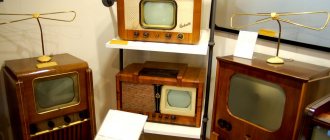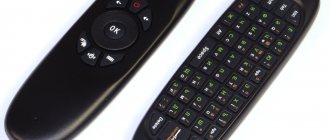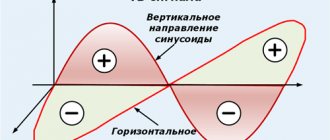On modern TVs, the input voltage parameters on the case proudly indicate the range from 140 to 270V. However, even the best device can fail due to power surges. Therefore, when buying an expensive model, it is recommended to immediately choose a 220V stabilizer for your TV. Calculating its power and other parameters is quite simple. Moreover, the price of the device will be lower than the cost of repairing a complex and expensive TV receiver.
Do you need a stabilizer for a modern TV?
Let's look at what it means to have such a wide range of permissible supply voltage indicated for a specific TV model. Yes, the device is capable of operating with such values of input parameters. Its internal stabilization circuits in the form of a switching power supply are quite tolerant of voltage surges.
However, voltage changes at the TV input must be smooth. With sharp throws, breakdowns are possible due, for example, to self-induction phenomena or breakdowns of keys. The simplest accident that can occur is the internal fuse tripping. But this still means that the device will stop working until it is replaced.
The causes of the accident may be:
- powerful welding machine included on the line;
- power failures at the substation;
- burnout of the zero on the panel of the house, as a result of which a dephasing occurs and the voltage in the outlet can jump up to 380V;
- a sharp surge in voltage when turning off powerful equipment.
Important! An old Soviet voltage stabilizer for an LCD TV is only suitable for smooth voltage changes. It will protect against short-term powerful impulses. However, it is simply not capable of cutting off excess voltage levels. Therefore, modern TV requires a good, high-quality device.
What is a stabilizer
A stabilizer is a device that helps equalize voltage. It protects against surges when the voltage is exceeded or dropped to the average level. In case of strong changes, it turns off the equipment, thereby protecting it from burnout.
But you should know that not every TV stabilizer copes with the task, since most are designed for light loads. Therefore, an important factor when choosing is the power of the device. It is believed that for LCD TVs a system of 500, 220, 1000 W is quite sufficient.
Types of stabilizers
The best voltage stabilizer for a TV is selected according to a group of parameters. Some of them relate to its technical solution. Others are calculated according to the characteristics of the TV receiver. Today you can find several main types of stabilizers on sale. Which one to buy depends on the characteristics of the TV and the nature of voltage changes in the supply network.
Relay
The relay voltage stabilizer operates according to a fairly simple circuit. Its actuator has a group of contacts. Most often, they switch the secondary windings of the transformer, changing its conversion ratio to maintain the output voltage within a narrow range.
The 220V relay voltage stabilizer has two key disadvantages.
- Due to the limited number of switchings, voltage regulation is carried out with a noticeable delta. And the cheaper the stabilizer, the higher the rate of step change in the output parameter.
- The relay as such is quite short-lived. In a power network where voltage surges occur frequently, its motor life is consumed quickly. This means that the device will have to be repaired with enviable regularity.
Relay stabilizers have another disadvantage for the user: when switching, they make a loud click . At night it will interfere. Otherwise, the devices are very functional. The response speed is high, the range of acceptable input parameters is wide. Relay models are compact and practically do not heat up.
Servo-driven
The servo-drive stabilizer circuit includes a primary winding of the transformer and a secondary winding wound on a ring core. The conversion coefficient is adjusted to obtain the required voltage at the input by moving the current-collecting contact. This is done by an electric motor.
This device has disadvantages:
- the stabilizer slowly responds to changes in input voltage;
- the service life of current collecting brushes is limited;
- The engine requires care and periodic maintenance.
Servo-type stabilizers are quite heavy. But users often prefer them due to their high overall reliability and simplicity.
Thyristor, triac
Stabilizers on power switches have the highest response speed. Their electronic control circuit literally monitors voltage surges at the input in milliseconds and changes the operating mode of the output unit using triacs or thyristors.
Depending on the complexity of the device and its price, the user is offered different purities of sinusoid formation. It can have from 4 to 16 half-cycle steps. This feature is dictated by the nature of the keys’ operation. Their opening to power transport is instantaneous.
The main disadvantage of thyristor and triac units is the large heat generation . The stabilizer must be monitored and installed correctly. If it overheats, the power switch block may simply burn out. The devices are not cheap, but they operate absolutely quietly and require no maintenance.
Double conversion
Double conversion stabilizers use two circuits. One generates low voltage. The second is a stable day off. The devices are always built on semiconductor switches and are characterized by fast response and absolute noiselessness. Operation in fully controlled modes allows the devices to operate for a record long time. However, the cost of double conversion stabilizers is the highest on the market.
Important! When considering which device for normalizing the input voltage is best for an LCD TV, one cannot fail to mention uninterruptible power supplies for computers. They are quiet, reliable, stable. UPSs have minimal voltage regulation delta and are capable of providing sufficient output power to power a TV.
Required parameters
The stabilizer parameters are selected in accordance with the characteristics of the TV. First, the operating power requirements are determined. This can be done by looking at the operating instructions for the TV receiver. The table indicating the energy saving class contains all the necessary data.
To guarantee operation without overloads, it is recommended to choose a 220V voltage stabilizer for a TV with a power 30% higher than the requirements of the equipment connected to it. An indicator of 400-600 W is enough to power most modern TVs.
The second important parameter is phase. Everything is simple here. What kind of power supply is in your apartment or house, this is what you need to buy a stabilizer for your TV. That is, a device for 220V single-phase network or 380V three-phase. In the latter case, you can buy three single-phase solutions, connecting each of them between phase and zero.
Do all TVs need “stability”?
The question of purchasing a 220V voltage stabilizer for a TV has been around since the days of large tube models. With each current surge, the image on the display deteriorated, became distorted, and the color changed. Often after a thunderstorm it was necessary to repair or send the TV for repairs.
Modern technology based on matrices such as LED, LCD and plasma is equipped with a switching power supply. It supports current drops in a fairly wide range: from 170 to 250 V. As soon as the values go down or up, the TV automatically turns off. But, if for some reason this does not happen, there is a high probability of breakdown and subsequent repair of the TV.
Some manufacturers, for example, Samsung and LG, produce separate equipment for their TV models. This type of TV protection against power surges is reliable, but costs several times more than analogues from other companies.
It turns out that despite the built-in protection against current surges in TVs, they need a separate stabilizer, especially if the light bulbs in the house blink very often and the lights turn off.
When exactly do you need an uninterruptible power supply?
Despite the presence of a built-in stabilizer in LCD and LED TVs, there are situations when additional equipment is definitely required:
- Constant power surges in the house due to old wiring, frequent thunderstorms and winds.
- A private house where there are always problems with the intensity of the current supply.
- There are often renovation works or construction of new houses going on nearby - there is a high probability that cables will be damaged during construction.
Before purchasing a device, you can measure the total voltage in the network in the house for one or two days. To do this, you need to purchase or borrow a tester from someone. And check the indicators every 1-2 hours.
Such an analysis will help to understand whether a stationary or mainline device is needed. After all, it is better to protect once than to repair appliances in the house many times.
Important! The main uninterruptible power supply is mounted as close as possible to the switchboard. It is advisable to install it immediately after the meter.
Do not confuse pixel burnout on the matrix with the consequences of power surges. Pixels are control transistors. And they do not fail due to voltage. But a complete failure or disappearance of the picture as a whole is already a sign of voltage drops.
Recommended stabilizer models
To outline the range of options for choosing the optimal model, it is worth showing typical representatives of the voltage stabilizer market for TV.
SVEN VR-L600
This device from a well-known brand is simple and reliable. Its compact body houses two output sockets and one power switch. The relay stabilizer operates from 184 to 285V at the input, providing 198-253V at the output. The device has a rated power of only 200W, so it is only suitable for TVs with a small diagonal.
Important! Users especially note the low heat generation and low noise when switching the relay.
APC by Schneider Electric Line-R LS1000-RS
Another representative of relay stabilizers of the famous brand is suitable for all TVs. It has as much as 500W of rated power and safe output voltage levels of 198-242V. The device offers 10% delta adjustment. There is a color indication of modes. An attractive feature of the device is the ideal sine wave shape at the output. There are only three sockets on the case, no switches are provided.
RESANTA ACH-500/1-EM
This solution is an electromechanical type stabilizer. It provides an adjustment accuracy of 2% and supports output voltage from 216 to 224V. The device has a power of 500W and is suitable for any TV. A digital display is provided to display the output voltage. On the case there is only a power switch and a carrying handle. The stabilizer is designed for floor placement.
Energy Hybrid SNVT-500/1
This device is a hybrid type. This means that both electronic and electromechanical stabilization systems are used. The model has a power of 450 W, responds very quickly, and shows 3% adjustment accuracy. However, the peculiarities of its operation do not allow it to avoid drawdowns when the input voltage drops sharply. The stabilization speed is only 20V/s. The main advantage of the model is that it works with wide ranges of input and output voltages, as well as many protections against emergency situations .
Calm IS350
This device is a representative of the class of double conversion stabilizers. The model is distinguished by increased reliability, the ability to work with input voltage from 90 to 310 W, accuracy of 2% and a narrow output parameter limit from 216 to 224 V. The manufacturer provides a 10-year warranty for its product. The stabilizer is made in a wall-mounted housing and has a rated power of 300 W. It has one outlet and a thoughtful set of emergency protections.
Review of regulator models and their characteristics
This review presents models of inexpensive devices costing from 1,500 to 6,000 rubles.
- DefenderAVRInitial series 1000. Inexpensive automatic regulator with a power of 320 W. Equipped with a protection system against overheating and overloads, as well as a built-in surge protector. Compact device with an indicator of the current network status.
- DefenderAVR model iPOWER A medium-sized electronic device with a power of 300 W. Provides high speed and silent operation.
- SvenNeo R 600. Stabilizer capable of converting current intensity to 220V with an input value from 150 to 280V. The device is equipped with an additional function for filtering high-frequency interference. Which is especially important for such sensitive devices as televisions. This device automatically shuts down when overloaded, overheated or short-circuited.
- Uniel STR500 power 300 W. Convenient and compact regulator with a maximum power of 300 W. Capable of equalizing current intensity in the network from 145 to 280V at the input. Equipped with an indicator that shows the operating voltage and overload status.
It should be noted that purchasing regulators for each individual type of equipment is not advisable. Therefore, to ensure protection against shocks for all household appliances in the house, it is better to purchase a more powerful wall stabilizer. Such devices are distinguished by high power (about 8000 W) and are able to withstand significant voltage changes and loads.
If we are only talking about protecting an expensive TV or home theater, then in this case it is better to purchase a special small power regulator which will be enough for one device. Some television receivers have built-in stabilizers, but the power supplies of modern televisions are unable to fully protect the device from sudden and significant voltage surges. Therefore, purchasing a stabilizer will probably significantly extend the life of the device.
How to connect the selected model to TV
The 220V voltage stabilizer is connected according to the standard switching scheme for household appliances. It must be grounded. The stabilizer fork has a corresponding contact. In apartments built according to modern standards, it is enough to plug the device into a power outlet.
In old houses and private housing constructions, the electrical wiring diagram does not have a ground wire. For this case, there is a separate terminal on the device body. It is recommended to connect it to an external grounding system. For example, a group of steel rods driven into the ground around the perimeter of a building.
Important! Without this precaution, the device must not be used. If a breakdown occurs on the housing without grounding, the unit may catch fire or become a source of electrical injury.
And connecting the TV is as simple as possible: its plug is inserted into the socket on the stabilizer body. This completes all switching work.











